Naming compounds - Study guides, Class notes & Summaries
Looking for the best study guides, study notes and summaries about Naming compounds? On this page you'll find 581 study documents about Naming compounds.
Page 3 out of 581 results
Sort by
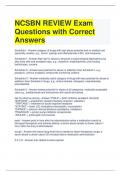
-
NCSBN REVIEW Exam Questions with Correct Answers
- Exam (elaborations) • 46 pages • 2024
-
- $12.49
- + learn more
NCSBN REVIEW Exam Questions with Correct Answers Schedule I - Answer-category of drugs with high abuse potential and no medical use (generally unsafe), e.g., heroin, lysergic acid diethylamide (LSD), and marijuana Schedule II - Answer-high risk for abuse or physical or psychological dependency but also have safe and accepted uses, e.g., morphine, amphetamines, short-acting barbiturates, cocaine Schedule III - Answer-less potential for abuse or addiction than Schedule II, e.g., paregoric, ...
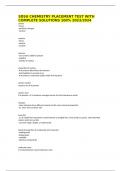
-
SDSU CHEMISTRY PLACEMENT TEST WITH COMPLETE SOLUTIONS 100% 2023/2024
- Exam (elaborations) • 6 pages • 2024
-
- $10.89
- + learn more
SDSU CHEMISTRY PLACEMENT TEST WITH COMPLETE SOLUTIONS 100% 2023/2024 proton -heavy -positively charged -nucleon neutron -heavy -neutral -nucleon electron -very small (1/1800 of proton) -negative -outside of nucleus properties of nucleus -# of protons determines the element -held together by nuclear force -# of protons is extremely stable unlike # of electrons atomic number equal to the # of protons atomic mass # of protons + # of neutrons averaged across a...
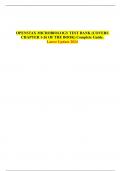
-
OPENSTAX MICROBIOLOGY TEST BANK (COVERS CHAPTER 1-26 OF THE BOOK) Complete Guide. Latest Update 2024
- Exam (elaborations) • 553 pages • 2024
-
- $17.48
- 1x sold
- + learn more
Opens tax Microbiology Test Bank Chapter 1 : An Invisible World Chapter 2 : How We See the Invisible World Chapter 3 : The Cell Chapter 4 : Prokaryotic Diversity Chapter 5 : The Eukaryotes of Microbiology Chapter 6 : Acellular Pathogens Chapter 7 : Microbial Biochemistry Chapter 8 : Microbial Metabolism Chapter 9 : Microbial Growth Chapter 10 : Biochemistry of the Genome Chapter 11 : Mechanisms of Microbial Genetics Chapter 12 : Modern Applications of Microbial Genetics Chapter 13 :...
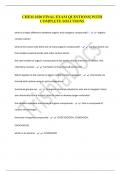
-
CHEM 1020 FINAL EXAM QUESTIONS| WITH COMPLETE SOLUTIONS
- Exam (elaborations) • 17 pages • 2024
-
- $9.99
- + learn more
CHEM 1020 FINAL EXAM QUESTIONS| WITH COMPLETE SOLUTIONS what is a major difference between organic and inorganic compounds? - -organic contain carbon what is the reason why there are so many organic compounds? - -carbon atoms can form stable covalent bonds with other carbon atoms the vast number of organic compounds is due to the unique chemistry of carbon. this chemistry involves - -formation of long chains& isomerism Which applies to the manner in which carbon bonds in alkanes? - -the ...
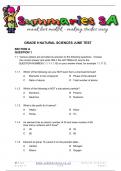
-
Grade 9 Natural Sciences (NS) June Paper and Memo - 2024
- Exam (elaborations) • 9 pages • 2024
-
- $2.86
- + learn more
Grade 9 Natural Sciences June Paper and Memo: Total: 100 Marks. Contents of the exam paper contains the following details: Periodic Table Naming & formulas of compounds Chemical Reactions Reactions with Oxygen Acids and Bases This is a practice paper with memorandum meant to test the student's knowledge, and will not be the same paper written for the exam. THE SMI
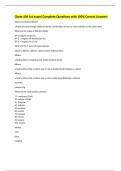
-
Chem 104 1st exam|Complete Questions with 100% Correct Answers
- Exam (elaborations) • 24 pages • 2024
-
- $14.00
- + learn more
Chem 104 1st exam|Complete Questions with 100% Correct Answers What are hybrid orbitals? orbitals of equal energy produced by the combination of two or more orbitals on the same atom What are the types of hybrid orbitals SP- 2 regions of density SP^2- 3 regions of density(3sp^2s) SP^3- 4 regions (4 sp^3s) What are the 4 types of hydrocarbons alkanes, alkenes, alkynes, and aromatic hydrocarbons Alkane a hydrocarbon containing only single covalent bonds Alkene a hydrocarbon that contai...
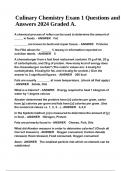
-
Culinary Chemistry Exam 1 Questions and Answers 2024 Graded A.
- Exam (elaborations) • 33 pages • 2024
-
- $13.99
- + learn more
Culinary Chemistry Exam 1 Questions and Answers 2024 Graded A. A chemical process of reflux can be used to determine the amount of ______ in foods. - ANSWER Fat _________ are known to build and repair tissue. - ANSWER Proteins The FDA allows for _______ % leeway in information reported on nutrition labels. - ANSWER 5 A cheeseburger from a fast food restaurant contains 19 g of fat, 20 g of carbohydrate, and 28 g of protein. How many kcal of energy does the cheeseburger contain? (The calor...
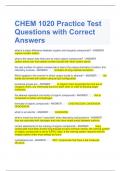
-
CHEM 1020 Practice Test Questions with Correct Answers
- Exam (elaborations) • 12 pages • 2024
- Available in package deal
-
- $12.99
- + learn more
CHEM 1020 Practice Test Questions with Correct Answers what is a major difference between organic and inorganic compounds? - ANSWER organic contain carbon what is the reason why there are so many organic compounds? - ANSWER carbon atoms can form stable covalent bonds with other carbon atoms the vast number of organic compounds is due to the unique chemistry of carbon. this chemistry involves - ANSWER formation of long chains& isomerism Which applies to the manner in which carbon bonds...
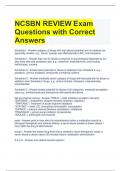
-
NCSBN REVIEW Exam Questions with Correct Answers
- Exam (elaborations) • 46 pages • 2024
- Available in package deal
-
- $13.49
- + learn more
NCSBN REVIEW Exam Questions with Correct Answers Schedule I - Answer-category of drugs with high abuse potential and no medical use (generally unsafe), e.g., heroin, lysergic acid diethylamide (LSD), and marijuana Schedule II - Answer-high risk for abuse or physical or psychological dependency but also have safe and accepted uses, e.g., morphine, amphetamines, short-acting barbiturates, cocaine Schedule III - Answer-less potential for abuse or addiction than Schedule II, e.g., paregoric,...
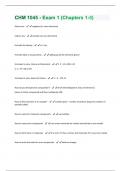
-
CHM 1045 - Exam 1 (Chapters 1-3) Questions With 100% Correct Answers
- Exam (elaborations) • 4 pages • 2024
- Available in package deal
-
- $8.39
- + learn more
Anions are - negative (ie, more electrons) Cations are - positive (ie, less electrions) Formula for density - d = m/v Formula Mass is measured by - adding up all the elements g/mol Formulas to conv. Celsius to Fahrenheit - 1. F = (C x 9/5) +32 2. C = (F +32) x 5/9 Formulas to conv. Kelvin to Celsius - C = K - 273.15 How do you find percent composition? - (# of element)(atomic mass of element) / (mass of entire compound) and then multiply by 100 How to find neutrons in an isotope? - numb...

That summary you just bought made someone very happy. Also get paid weekly? Sell your study resources on Stuvia! Discover all about earning on Stuvia


